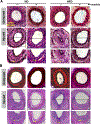Imatinib improves insulin resistance and inhibits injury-induced neointimal hyperplasia in high fat diet-fed mice
- PMID: 33131722
- PMCID: PMC7749815
- DOI: 10.1016/j.ejphar.2020.173666
Imatinib improves insulin resistance and inhibits injury-induced neointimal hyperplasia in high fat diet-fed mice
Abstract
Imatinib, a PDGF receptor tyrosine kinase inhibitor, has been shown to suppress intimal hyperplasia in different animal models under normal metabolic milieu, diabetic, and/or hypercholesterolemic conditions. However, the impact of imatinib treatment on injury-induced neointimal hyperplasia has not yet been investigated in the setting of insulin resistance without frank diabetes. Using a mouse model of high fat diet (HFD)-induced insulin resistance and guidewire-induced arterial injury, the present study demonstrates that intraperitoneal administration of imatinib (25 mg/kg/day) for ~3 weeks resulted in a marked attenuation of neointimal hyperplasia (intima/media ratio) by ~78% (n = 6-9 per group; P < 0.05). Imatinib treatment also led to significant improvements in key metabolic parameters. In particular, imatinib improved insulin resistance and glucose tolerance, as revealed by complete inhibition of HFD-induced increase in HOMA-IR index and AUCIPGTT, respectively. In addition, imatinib treatment led to diminutions in HFD-induced increases in plasma total cholesterol and triglycerides by ~73% and ~59%, respectively. Furthermore, imatinib decreased HFD-induced increase in visceral fat accumulation by ~51% (as determined by epididymal white adipose tissue weight). Importantly, imatinib treatment in HFD-fed mice enhanced plasma levels of high-molecular-weight adiponectin by ~2-fold without affecting total adiponectin. However, there were no significant changes in mean arterial pressure in insulin-resistant state or after imatinib exposure, as measured by tail-cuff method. Together, the present findings suggest that targeting PDGF receptor tyrosine kinase using imatinib may provide a realistic treatment option to prevent injury-induced neointimal hyperplasia and diet-induced insulin resistance in obesity.
Keywords: Adiponectin; Arterial injury; Imatinib; Insulin resistance; Neointimal hyperplasia; PDGF.
Copyright © 2020 Elsevier B.V. All rights reserved.
Conflict of interest statement
Declaration of competing interest
The authors declare no conflict of interests.
Figures






References
-
- Abderrahmani A, Yengo L, Caiazzo R, Canouil M, Cauchi S, Raverdy V, Plaisance V, Pawlowski V, Lobbens S, Maillet J, Rolland L, Boutry R, Queniat G, Kwapich M, Tenenbaum M, Bricambert J, Saussenthaler S, Anthony E, Jha P, Derop J, Sand O, Rabearivelo I, Leloire A, Pigeyre M, Daujat-Chavanieu M, Gerbal-Chaloin S, Dayeh T, Lassailly G, Mathurin P, Staels B, Auwerx J, Schurmann A, Postic C, Schafmayer C, Hampe J, Bonnefond A, Pattou F, Froguel P, 2018. Increased Hepatic PDGF-AA Signaling Mediates Liver Insulin Resistance in Obesity-Associated Type 2 Diabetes. Diabetes 67, 1310–1321. - PubMed
-
- Auger KR, Serunian LA, Soltoff SP, Libby P, Cantley LC, 1989. PDGF-dependent tyrosine phosphorylation stimulates production of novel polyphosphoinositides in intact cells. Cell 57, 167–175. - PubMed
-
- Baroni MG, D’Andrea MP, Montali A, Pannitteri G, Barilla F, Campagna F, Mazzei E, Lovari S, Seccareccia F, Campa PP, Ricci G, Pozzilli P, Urbinati G, Arca M, 1999. A common mutation of the insulin receptor substrate-1 gene is a risk factor for coronary artery disease. Arterioscler. Thromb. Vasc. Biol 19, 2975–2980. - PubMed
-
- Boucher P, Gotthardt M, Li WP, Anderson RG, Herz J, 2003. LRP: role in vascular wall integrity and protection from atherosclerosis. Science 300, 329–332. - PubMed
MeSH terms
Substances
Grants and funding
LinkOut - more resources
Full Text Sources
Other Literature Sources

